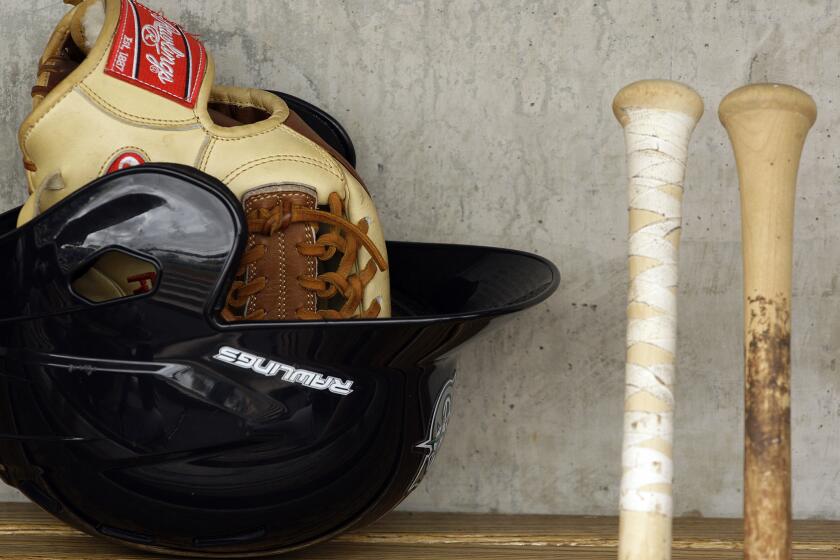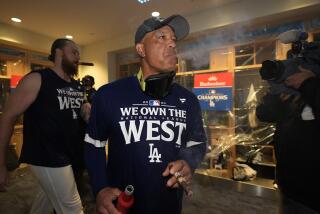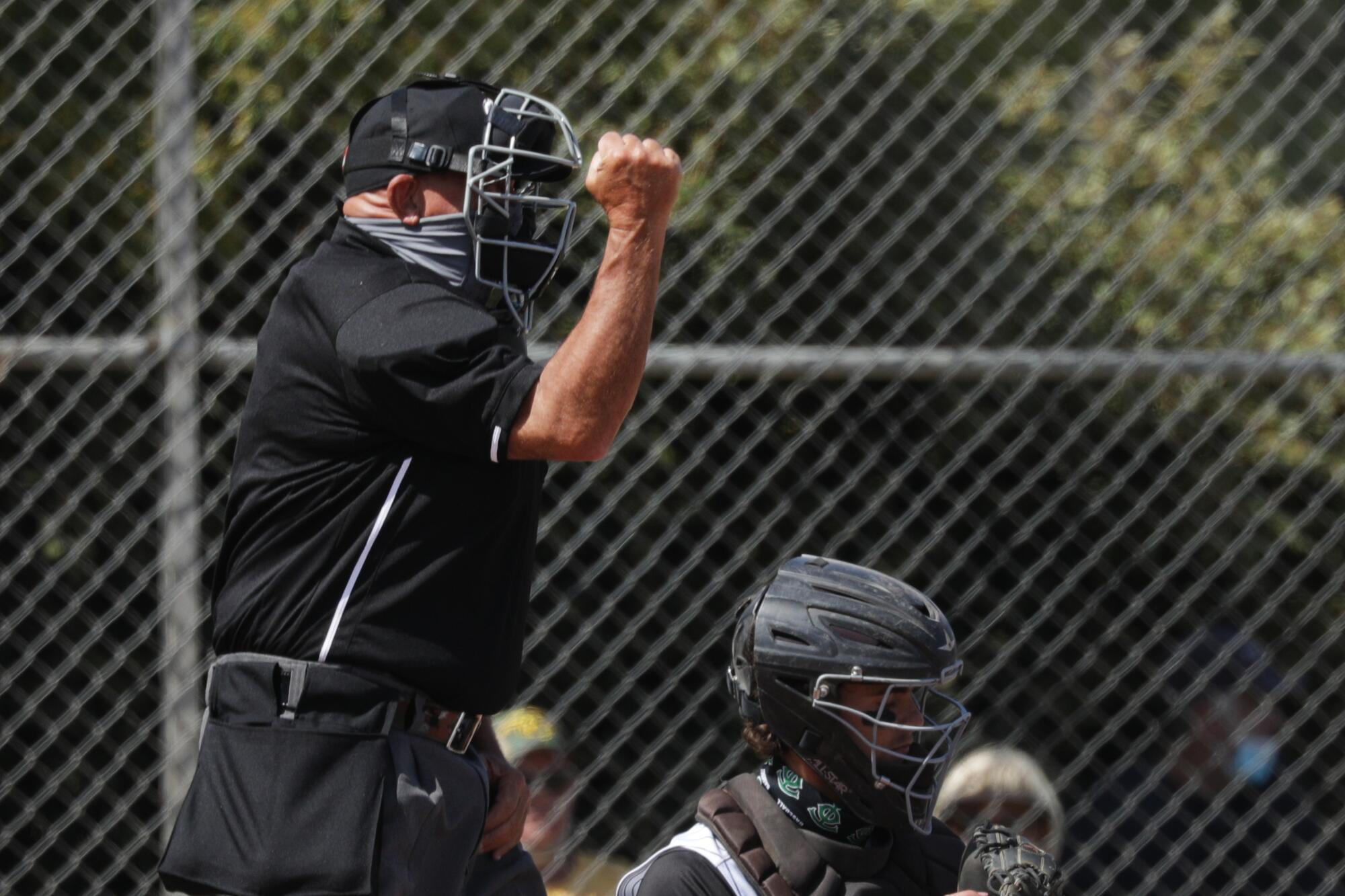
Anyone who has participated in sports remembers the thought. It struck first when you woke up, maybe again after lunch.
It triggered anticipation, butterflies and delight.
I’ve got a game today.
Many years after playing a team sport for the last time, that thought still occurs to me regularly. I’m with the Channel Coast Officials Assn., which provides officials at high school games from Calabasas to Santa Barbara. I’m privileged to be a baseball umpire, along with my partner the only people besides players allowed between the foul lines.
We strive to be invisible. If umpires are discussed after a game, we probably didn’t do a spectacular job. When we’re not noticed, that’s spectacular enough. We relish being the only people who don’t care who wins.
It’s reward enough to be constantly learning, hopefully improving at something physically and mentally challenging at an age when others might be content on a couch.
The lessons take many forms. As the base umpire at a game at Thousand Oaks High this season, I looked to my left and noticed the first base coach, Rod Stillwell, backed up a good 10 feet behind the coach’s box.
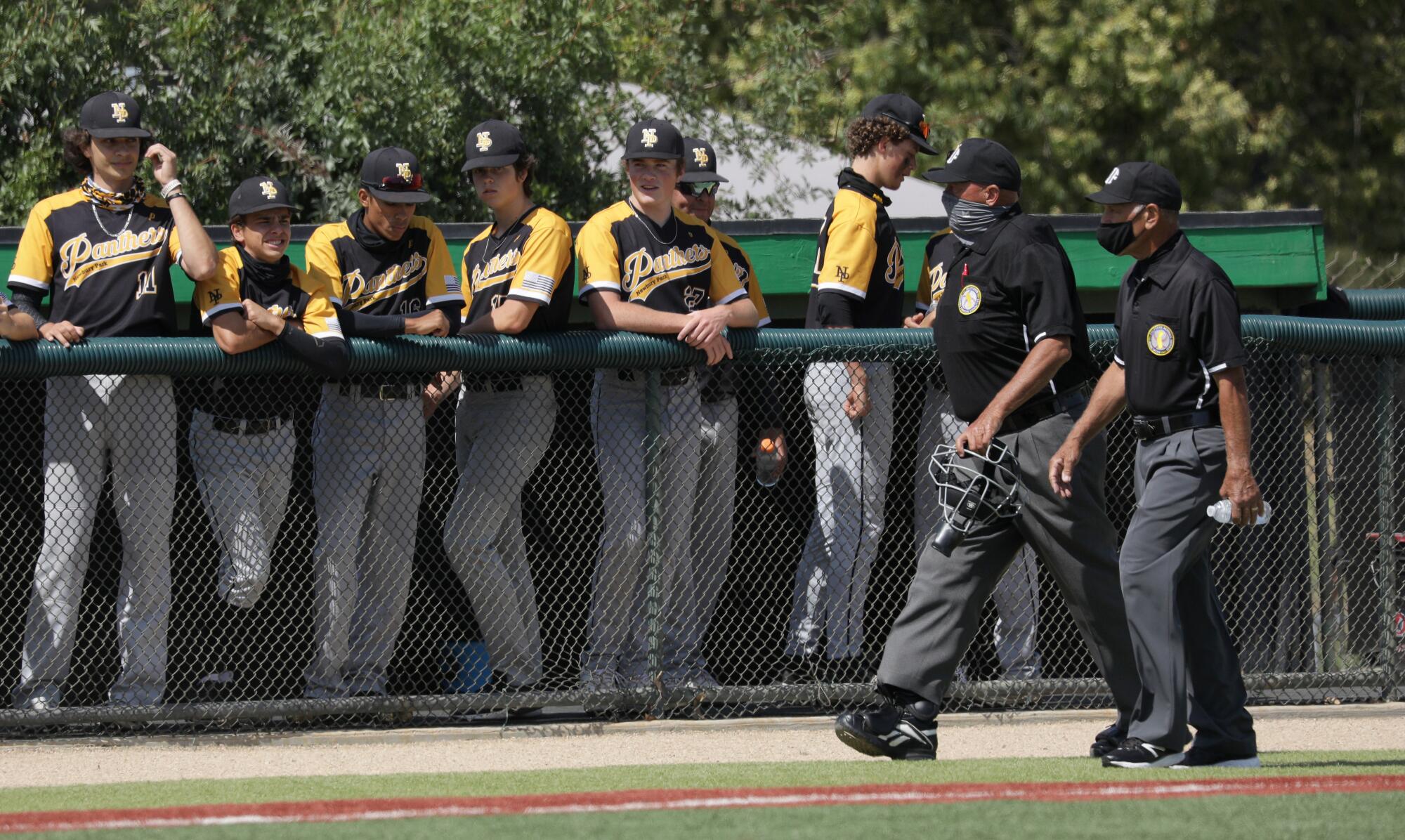
Stillwell led Thousand Oaks to its only Southern Section title in 2003, and his brother Kurt enjoyed a long major league career. He knows the game, and if he backed up it was for a good reason. What’s up? I asked.
“This guy scares me,” he said, nodding toward the batter’s box, where stood left-handed Roc Riggio, the subject of well-deserved headlines for his power.
The opposing first baseman, meanwhile, crept forward, anticipating a bunt. I knew I should move up a few steps as well, so if a low line drive was hit to the first baseman, I could determine if it was a catch or a trap.
I felt like yelling to the first baseman, “Roc Riggio is not going to bunt!” but, of course, I couldn’t do that. My choice was proper umpire positioning or self-preservation, and I stepped forward. Riggio turned on a pitch and hit a rocket the right fielder caught at the warning track. I exhaled and so did Stillwell.
The head coach at Thousand Oaks is Jack Wilson, for 12 years a major league shortstop. He’s one of several former major leaguers coaching in the Channel Coast umpire circuit. As a sports journalist of more than 35 years, I wrote stories about several of them long before they became coaches and I became an umpire.

Dmitri Young gives me a sly grin and asks if I’m carrying my pen and notepad. Joe Borchard reminisces about the time I interviewed him during an all-you-can eat crab dinner. Jeff Weaver gives me a “What are you doing here” look, as if I’m engaged in participatory journalism like George Plimpton in “Paper Lion.” Then the game begins and they become “coach” and I become “blue.”
Wonder what became of Billy Ashley, the Dodgers slugger from the 1990s? He found his bliss as coach of the Malibu High Sharks.
An assignment to umpire at Malibu is a treat, the field perched on a bluff overlooking the Pacific, just across PCH and Zuma Beach. A family of squirrels — beachcombing squirrels, if there is such a thing — nibbles on pristine green grass in right-center field. Spectators set up chairs and blankets on a slope of lawn above the third-base line with a priceless view of the game, the squirrels and the ocean.
Ashley loves to give the bunt sign. In one inning of a game a few weeks ago he called for nine consecutive bunts, fueling the unlikeliest of rallies.
Between batters, my partner and I exchange signals when the infield fly rule is a possibility or to indicate with a runner on first that on a hit to the outfield the plate umpire will take the call at third base. When every batter is bunting, those scenarios don’t occur. We signal anyway.
Orange Lutheran moved up to No. 1 in The Times’ top 25 baseball rankings, replacing Thousand Oaks, which suffered its first loss to Newbury Park.
A week later I’m at Malibu again and can’t help but ask Ashley, “Did Lasorda ever ask you to bunt?”
“Nope,” he replies, chuckling. “Not me.”
Many fields aren’t as well-manicured as Malibu. Brushing off home plate at the Oak Park High junior varsity field, I notice a hole in the right-handed batter’s box. I kick dirt over it, the dirt disappears and the hole remains. The catcher’s eyes widen: “We’ve tried to fill that hole all year. You can’t do it. Who knows how deep it goes?”
Players emulate major leaguers in subtle ways. After watching MLB plays get overturned on replay, high school infielders hold tags longer in the hope runners overslide the bag. It reinforces a cardinal rule of umpiring: don’t rush, allow a play to finish, wait another beat, then make the call.
Training is a collaborative process, with veteran umpires supervising clinics and the entire association attending meetings — on Zoom this year — to conduct deep dives into obscure rules, thorny situations and who will cater our annual banquet.
An umpire is always one blown call away from abject humiliation, and these days that can include repeated views on the social media accounts of teams and players.
Like most endeavors, repetition is the key to improvement. Get out there and umpire. Expect the unexpected, even before a game starts.
Minutes before a game, I strap on my shin guards then tighten the laces on my shoes ... Snap! … A lace breaks. I dip into the trunk of my car and frantically rummage through what veteran umpire Tom Tenney calls an “Oh Crap! Bag.” It’s stuffed with everything an umpire might forget after leaving for a game: ball bags, belt, socks, shoes, protective cup, ball-strike indicator … and, whew!, shoestrings.
This year, there is an additional accessory. Plate umpires wear two masks — one to protect from the virus, the other to protect our faces from a foul ball or errant pitch. It’s not the epitome of comfort.
After missing most of the 2020 season and the first part of 2021 to the pandemic, players, coaches and fans griped less early on than in previous years. Players were overjoyed to be on the field, finally seeing teammates somewhere other than Zoom, and the adults in their lives followed suit. Nobody was taking the season for granted.
With league play underway and playoff berths on the line, however, competition heightened and friction increased. Before ejecting a coach, a football official can throw a flag for unsportsmanlike conduct, and a basketball official can call a technical foul. Baseball umpires had no such intermediary sanction until recently: Now in high school an umpire can restrict a coach to the dugout for arguing too vociferously before resorting to an ejection.

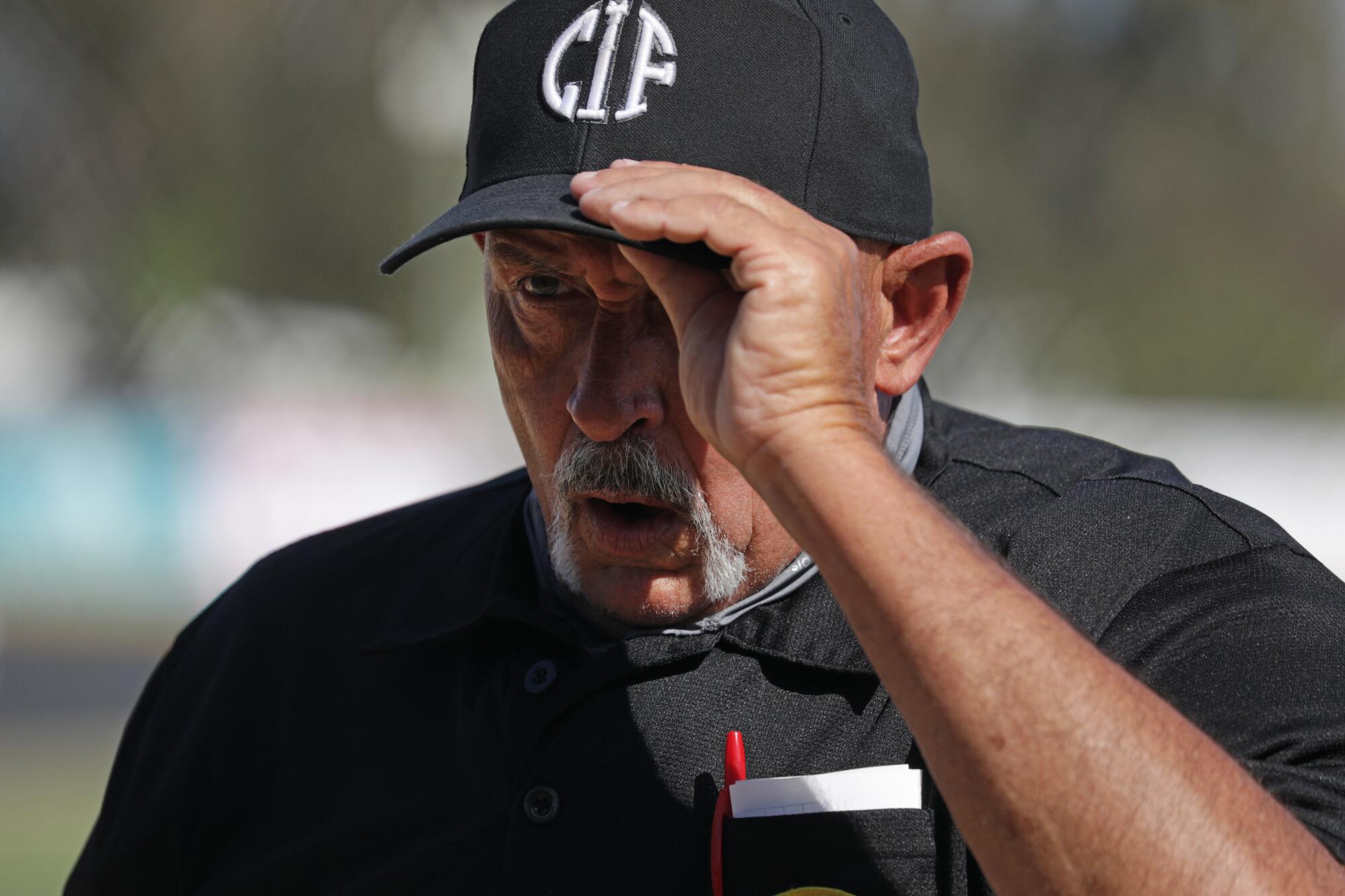
An umpire is always one blown call away from abject humiliation, and these days that can include repeated views on the social media accounts of teams and players. Every pitch is captured on video by somebody.
That scrutiny fosters camaraderie in our ranks. Longtime major league umpires and SoCal residents Gerry Davis and Brian Gorman spoke to our Channel Coast unit over Zoom this spring and were incredibly generous with their time, taking questions and offering advice. I was spellbound.
Davis is approaching the 5,000th game of his 40-year major league career. Three umpires have exceeded 5,000 games, and Joe West set the record this week calling his 5,376th game. Assuming one out of every four games was behind the plate with an average of 290 pitches a game, West has called about 390,000 pitches in his career. I’ve called 32 games during this abbreviated high school season along with a handful of youth games, not a bad load but minuscule compared to the likes of Davis and West.
Advancing as a high school umpire is not unlike advancing as a player: begin at the freshman level, move up to JV, then to varsity. Only one umpire is assigned to games below varsity, and they can be challenging. Hustling out from behind home plate to get a good look at calls on the bases is essential.
More than 90% of calls are these six: ball, strike, safe, out, fair, foul. Get those right and most games will be smooth.
Another challenge awaits in the playoffs when crews grow to three umpires. Positioning becomes more complicated, so Channel Coast umpires spent a recent Sunday reviewing three-man mechanics while volunteering at youth travel ball games. Pay is rarely a consideration anyway: Compensation for high school games is $84, and most umpires spend several hundred dollars replenishing uniforms and equipment every year.
Difficult calls include tags during a rundown or a batter fouling a pitch off his foot. In both instances a player can block the umpire’s view of the tag or the ball. I’ve learned to wait, to recognize players’ reactions and body language before making the call. Again, there’s no hurry. Nobody has ever yelled at an umpire for taking too long to make a call.
Occasionally something weird happens and immediately applying a rule is necessary. But more than 90% of calls are these six: ball, strike, safe, out, fair, foul. Get those right and most games will be smooth.
As long as the catcher does his job. Catchers are an umpire’s best friend — most of the time. A few times a year, a breaking ball in the dirt will bounce into the umpire’s solar plexus or groin. Even more infrequent, but always memorable, is an inside fastball the catcher misses altogether that strikes the umpire dead-on.
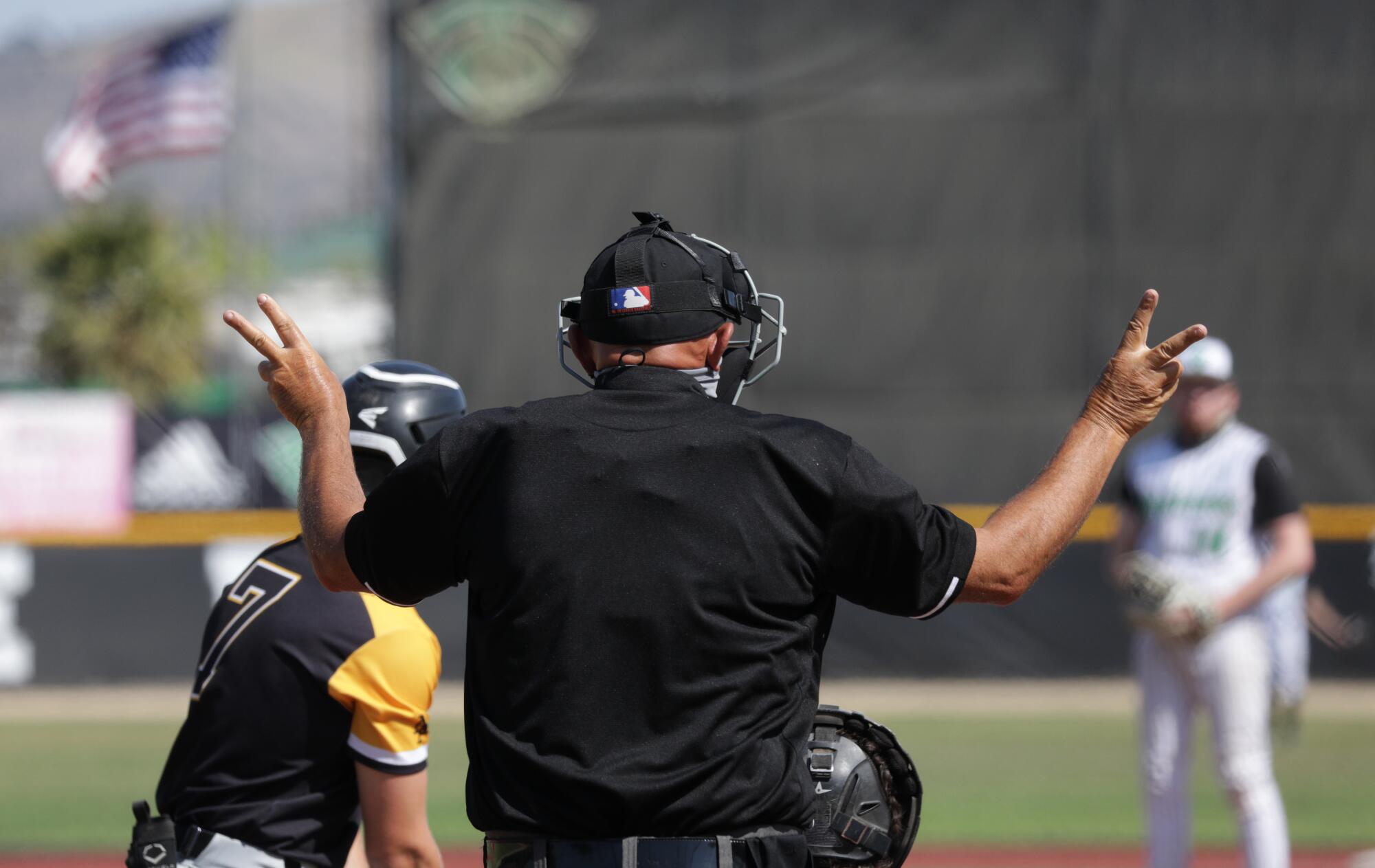
That round bone that protrudes from your wrist? I took an 80-something mph fastball a few weeks ago that left a tattoo from the ball’s seams looking like a snake bite directly on that bone. The catcher turned to me and rather lamely said, “My bad.”
I finished the game, iced my wrist at home and typed through the pain for a few days. But it didn’t interrupt my season. My pants are pressed. My shoes are shined. The thought strikes anew.
I’ve got a game today.
Get our high school sports newsletter
Prep Rally is devoted to the SoCal high school sports experience, bringing you scores, stories and a behind-the-scenes look at what makes prep sports so popular.
You may occasionally receive promotional content from the Los Angeles Times.
More to Read
Go beyond the scoreboard
Get the latest on L.A.'s teams in the daily Sports Report newsletter.
You may occasionally receive promotional content from the Los Angeles Times.
